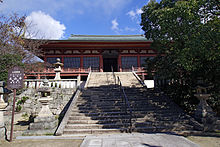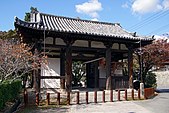Taisan-ji (Kobe)
The Taisan-ji ( Japanese 太 山寺 ) with the mountain name Sanshin-zan (三 身 山) is a temple of the Tendai direction of Buddhism in the city of Kobe in Hyōgo prefecture . It is the 25th temple on the New Saigoku Pilgrimage Route .
history
The eldest son of Fujiwara no Kamatari , Jōe-oshō ( 定 恵 和尚 ), decided to have a temple built in 716, which his grandson Umakai ( 宇 合 ) did with the construction of the building including the pagoda. Umakai is said to have been looking for relaxation in a nearby hot spring when the healing Buddha Yakushi Nyorai appeared to him in a dream and ordered him to build a complete temple complex, within which he was then venerated. For Emperor Genshō , the temple became a temple of prayer, other emperors followed this example until the whole population venerated the temple.
When Prince Daito no Miya Moriyoshi fought against the Hōjō at the end of the Kamakura period , he instructed the temple to support the troops of Akamatsu Norimura (赤松 則 村; 1277-1350). For this purpose, a fortified facility was built on a mountain north of the temple.
The temple experienced its heyday at the time of the north and south courtyards in the 14th century. At that time the temple was surrounded by 41 Klausen, 8 branch temples and 4 shrines. From the Klausen only the Ryūzō-in ( 龍 象 院 ), the Jōju-in ( 成就 院 ), the An'yō-in ( 安 養 院 ) and the Kanki-in ( 歓 喜 院 ) are preserved.
The attachment
The temple guardian gate ( 仁王 門 , Niō-mon ) standing a few hundred meters in front of the temple is registered as an important cultural asset of Japan . It was moved here from another place, the statues of the temple guards are no longer there. It was originally a towering two-story gate 3 ken wide , but after the relocation the upper story was abandoned and the ridge was made simpler. These are the results of a disassembly for repair in 1958.
On the way to the inner temple area one passes the garden of the sub-temple An'yō-in ( 安 養 院 ). It comes from the Momoyama period and is registered as a beautiful sight on the national level ( 国 名勝 , Kunimeishō).
The main hall ( 本 堂 , Hondō ) is registered as a national treasure, it is the only national treasure within the city of Kobe. The original hall burned down in early 1285, the current one is likely to date from 1300. The hall is divided into a front area ( 外 陣 , Gejin ) and an inner area ( 内 陣 , Naijin ). In the inner area is the cult figure of the temple, the healing Buddha ( 薬 師 如 来 , Yakushi Nyorai ). Together with the other groups of figures, the arrangement is a typical example of a prayer room in esoteric Buddhism. During the major overhaul of the building in 1964, the roof was partially covered with bricks to completely covered with copper sheet.
On a corner next to the main hall is a memorial stone for the representative of the Yōmei doctrine Kumazawa Banzan ( 熊 澤 蕃 山 ; stage name Sokuyūken ( 息 遊 軒 ); 1619-1691). This had been invited as a teacher by the ruling daimyo Ikeda Mitsumasa ( 池田 光 政 ; 1609–1682) and had his residence nearby. He was active at the Han school Hanabatake Kyōjō ( 花 畠 教 場 ) in Okayama .
The three-story pagoda ( 三重 塔 , Sanjū-no-tō ) to the right of the main hall dates from 1688 and is registered as an important cultural asset of the prefecture. It has staggered roofs, which - in contrast to old pagodas - hardly differ in size, which is typical of the Edo period . On the ground floor, a Kongōkai Dainichi Nyorai ( 金剛 大 日 如 来 ), who is protected by the Four Kings of Heaven , is venerated. The prayer room is not open to the general public.
Further to the left is the Amida Hall ( 阿 弥陀 堂 町 ) from 1688. It stands for the worship hall ( 修行 堂 , Shugyōdō) that is usually found in temples of the Tendai doctrine for devotional rites. The venerated seated Amida Buddha comes from the beginning of the Kamakura period and is registered as an important cultural asset. It resembles the 150 years older Amida from the Phoenix Hall of the Byōdō-in in appearance and size (2.74 m).
Treasures of the temple
As important cultural assets, the temple has 11 paintings, 9 objects of the arts and crafts (armor ( yoroi ) and other) and 3 old documents, including the Daitō no Miya reishi oyobi chushin-jō ( 大 塔 宮 令 旨 及 注 進 状 ), which contains the instructions of Prince Taitō no Miya for the suppression of the Kamakura regime from 1344.
Remarks
- ↑ The Yōmei doctrine is a neo-Confucian doctrine that goes back to Wang Yangming , Japanese Ō Yōmei ( 王 陽明 ; 1473-1529).
literature
- Hyōgo-ken no rekishi sampo henshu iinkai (ed.): Taisan-ji. In: Hyogo-ken no rekishi sampo (jo). Yamakawa Shuppan, 2012, ISBN 978-4-634-24628-7 .
Web links
Coordinates: 34 ° 41 ′ 47.4 " N , 135 ° 4 ′ 1.2" E




